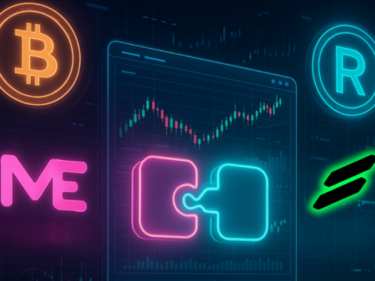The Future of the Bitcoin Ecosystem: Pioneering Innovations from Native DeFi to Layer 1.5
-
 by Dr. Steven Brule
by Dr. Steven Brule
- March 11, 2025

The Bitcoin ecosystem is on the brink of a transformative boom, with innovations emerging across several key sectors. As we look ahead to later this year and early 2026, there are four major areas poised to redefine how Bitcoin operates: native Bitcoin DeFi applications, chain abstraction, Bitcoin layer 2/side chains, and trusted execution environments (TEE) in the form of Bitcoin layer 1.5. In this article, we dive into these transformative sectors and explore why the future of Bitcoin is not just about digital gold—but a vibrant, multifunctional network of financial and computational innovation.

1. Native Bitcoin DeFi Applications: Unlocking New Financial Opportunities
Bitcoin has long been heralded as a secure store of value, but its ecosystem is rapidly evolving to support innovative decentralized finance (DeFi) applications built directly on the Bitcoin layer 1. Two groundbreaking projects are leading this charge:
Liquidium: Empowering Borrowing and Lending with Bitcoin Assets
Liquidium is pioneering a borrowing and lending platform that leverages Bitcoin ordinals, runes, and more. This platform allows users to utilize their Bitcoin-centric assets as collateral to secure loans. By tapping into a vibrant network of lenders and borrowers, Liquidium is redefining how Bitcoin is used beyond a simple store of value.
Fluid Tokens: A New Approach to Bitcoin DeFi
Building on similar principles, Fluid Tokens started as a borrowing and lending platform but quickly evolved to include a unique Bitcoin native staking mechanism. Fluid’s team, with deep roots in the Cardano blockchain and extensive UTXO expertise, has crafted a non-custodial staking solution. Users can lock up assets like ordinals or runes into a dedicated staking wallet until a predetermined block height is reached, earning rewards along the way. This innovative staking vault is a first for retail users on Bitcoin layer 1, showcasing the immense potential of native Bitcoin DeFi applications.
2. Chain Abstraction: Bridging Bitcoin with New Computational Frontiers
One of the most exciting developments in the Bitcoin ecosystem is chain abstraction—a methodology that empowers Bitcoin wallet users to continue managing their Bitcoin assets while interacting with a variety of computational platforms. This approach enables seamless integration with environments such as the Merlin chain, ICP, Near Protocol, and Solana.
Why Chain Abstraction Matters
- Enhanced Computation: Bitcoin’s native layer is limited in its computational capabilities. Chain abstraction offloads complex computations to specialized platforms, thereby broadening the functional scope of Bitcoin assets.
- Interoperability: By allowing Bitcoin to interface with established layer 1 communities like Cardano, Near Protocol, and ICP, chain abstraction ensures that Bitcoin remains relevant and integrated within a broader blockchain ecosystem.
- User Empowerment: Bitcoin holders can enjoy the security of their primary wallet while engaging in diverse applications, from smart contracts to advanced financial instruments, without leaving the Bitcoin network.
3. Bitcoin Layer 2/Side Chains: Scaling and Enhancing Functionality
While Bitcoin layer 1 offers unparalleled security, its scalability and computational limits have paved the way for layer 2 solutions and side chains. These developments promise to offer enhanced functionality while maintaining the integrity of Bitcoin’s underlying architecture.
Key Players in the Bitcoin Layer 2 Space
- Merlin Chain: Launched in February 2024, Merlin Chain stands out for its ability to bridge Bitcoin layer 1 assets—such as ordinals, runes, BRC-20s, and bitmaps—into a broader financial ecosystem. Additionally, its participation in BTCfi allows for innovative staking and restaking solutions.
- Stacks: As an early Bitcoin layer 2 solution, Stacks utilizes a unique tech stack that differs from many newer EVM-based platforms. Despite slower adoption, Stacks has built a robust market cap and remains a key player in expanding Bitcoin’s utility.
- Core: With strong backing from investors like Coinbase Ventures, Core launched in early 2024 and quickly secured a listing on Coinbase Exchange. Its rapid growth and diverse app onboarding strategy underscore its potential to lead Bitcoin layer 2 innovations.
- Emerging Platforms: Other noteworthy projects include Bit Layer, Botanics, and Hemi, each offering unique approaches to extending Bitcoin’s reach through side chains.
4. TEE Layer 1.5: The Hybrid Future of Bitcoin Innovation
Trusted Execution Environments (TEEs) represent a hybrid approach, often referred to as Bitcoin layer 1.5, that combines the security of Bitcoin layer 1 with additional functionalities from secondary environments. These platforms offer flexible solutions for developers, enabling them to tailor applications that leverage both Bitcoin’s robust security and the enhanced capabilities of modern blockchain infrastructures.
Leading TEE Initiatives
- Arch Network: Arch Network is building an environment specifically designed for Bitcoin native applications. Developers can choose the degree of Bitcoin integration versus a more dedicated Arch SVM experience, creating a versatile platform for innovation.
- Near Protocol’s Hybrid Environment: Though not yet officially named, multiple projects are underway that mirror Arch Network’s approach, utilizing a three-pronged security model. This model incorporates MPC (Multi-Party Computation), tangible hardware security measures, and sharding signers to ensure robust protection of Bitcoin assets.
- ICP and Valhalla: Another exciting development is ICP’s Bitcoin layer 1.5 environment, dubbed Valhalla. With the launch of applications like Odin.fun, Valhalla is set to expand its ecosystem by introducing prediction markets, as well as perpetual and leveraged exchange applications. This blend of security and flexibility signals a significant evolution in how Bitcoin-based apps are built and deployed.
Looking Ahead: A Booming Future for the Bitcoin Ecosystem
The Bitcoin ecosystem is undergoing a quiet revolution. With native DeFi platforms like Liquidium and Fluid Tokens pushing the boundaries of what can be done directly on Bitcoin layer 1, the advent of chain abstraction is bridging gaps between Bitcoin and other blockchain communities. Meanwhile, the maturation of layer 2/side chains and the innovative potential of TEE layer 1.5 environments are setting the stage for a multi-dimensional Bitcoin experience.
For investors, developers, and blockchain enthusiasts, these developments offer unprecedented opportunities. The Bitcoin ecosystem is poised to become a vibrant, multi-sector arena that will redefine the landscape of digital finance and decentralized applications in the coming years. Stay tuned as these exciting innovations unfold and drive the next wave of growth in the world’s most iconic cryptocurrency.
Disclaimer: The above article is for informational purposes only and does not constitute financial advice. The cryptocurrency market is volatile and unpredictable; always conduct your research before investing.




